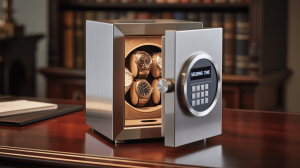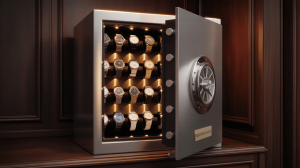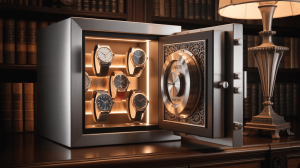Luxury Meets Security: Explore the Finest Watch and Jewelry Safes Today. But here’s the kicker… you can indulge in high-end display while safeguarding your most precious timepieces and gems with cutting-edge vaults that blend art and armor.
1. Defining Your Collection’s Security and Display Needs
Begin by auditing your watches and jewelry: count pieces, note sizes, and categorize by use frequency. Do you need daily-access winders or long-term display? Here’s the deal… understanding both protection levels (burglary, fire, humidity) and aesthetic desires guides your safe choice. Consider location lighting, room décor, and how visible you want your valuables to be.
| Requirement | Consideration | Outcome |
|---|---|---|
| Capacity | Number of watches/jewelry | Prevents overcrowding |
| Security Rating | UL RSC, ETL, UL 72 fire ratings | Balanced protection |
| Display Style | Glass front vs. hidden panel | Matches décor and visibility |
2. Choosing the Right Security Certifications
Not all safes measure up. Prioritize UL RSC or ETL burglary ratings and UL 72 Class 350 fire ratings (30–60 min @ 1,200 °F). Ready for the good part? These certifications prove a safe can withstand professional attacks and high temperatures, preserving oils, gems, and metal finishes.
3. Lock Mechanisms: Balancing Convenience and Redundancy
Lock options include mechanical dials, electronic keypads, biometric scanners, or dual-lock systems. Mechanical dials never die for lack of batteries; electronic codes offer timed delays and audit logs; biometrics grant fingertip access. Dual-lock models require two methods—ideal for ultra-high-value collections. Choose what fits your routine and risk tolerance.
4. Interior Layout: Modular Organization for Watches and Jewelry
A custom interior keeps pieces immaculate and accessible. Foam inserts, watch pillows, jewelry trays, and hidden tool pockets form a modular system. But here’s the kicker… interiors that convert winding bays into jewelry drawers give ultimate flexibility as your collection evolves.
| Component | Function | Advantage |
|---|---|---|
| Foam Watch Pillows | Secure individual watches | Prevents scratches and movement |
| Jewelry Trays | Rings, earrings, necklaces | Organizes by type, prevents tangling |
| Removable Winder Bays | Automatic watch winding | Dynamic reconfiguration |
5. Integrating Watch Winder Modules
Automatic timepieces require motion to stay precise. Look for winders offering 650–2,000 turns-per-day, CW/CCW/bi-directional modes, and quiet motors (< 25 dB). Built-in pause intervals avoid over-winding. Position winders at eye level for daily rotation, and assign static slots for manual watches.
6. Climate Control and Dust Sealing
Humidity can corrode metal, dry out leather, and fog sapphire crystals. Here’s the deal… seek IP54 door seals, desiccant chambers, or active dehumidifiers. Digital hygrometer displays keep RH between 40–50%. Filtered vents and tight gaskets block dust and airborne particles.
7. Aesthetic Finishes: Matching Décor with Luxury Materials
Safes now come in powder-coat steel, brushed aluminum, exotic wood veneers, or full-grain leather wraps. Tempered glass or acrylic viewing panels showcase your treasures. Ready for the good part? high-gloss piano lacquers or matte textured finishes integrate seamlessly into both contemporary lofts and classic studies.
| Finish Option | Style Impression | Durability |
|---|---|---|
| Matte Black Steel | Modern minimalist | Scratch and fingerprint resistant |
| Walnut Veneer | Warm, traditional elegance | Requires gentle maintenance |
| Leather Wrap | Rich, tactile luxury | Stain and wear resistant |
8. Integrated Lighting for Showcase Impact
LED strips, edge-lit glass, or fiber-optic spotlights highlight dials, gemstones, and metal textures without heat. Warm white enhances gold and leather tones; cool white accentuates steel and diamonds. Motion-activated switches power lights on demand and conserve energy.
9. Noise and Vibration Mitigation
Winder motors and locking bolts can introduce hum or clicks. Choose models with rubber-damped mounts, precision bearings, and soft-close hinges that keep noise under 25 dB. But here’s the kicker… whisper-quiet operation means your display safe fits elegantly into bedrooms and offices alike.
10. Smart Connectivity: Remote Monitoring and Alerts
Modern safes link via Bluetooth or Wi-Fi to send tamper alarms, door-open notifications, and climate data to your smartphone. Remote lock/unlock, audit logs, and winder adjustments happen in the app—so you stay connected to your collection even when away.
| Smart Feature | Capability | Benefit |
|---|---|---|
| Tamper Alerts | Instant push notifications | Immediate security awareness |
| Remote Control | Lock/unlock & TPD settings | Convenience on the go |
| Audit Logs | Entry history | Accountability and oversight |
11. Power Supply and Backup Strategies
Electronic locks and winders need reliable energy. Dual-power designs use AC adapters and rechargeable battery packs with low-battery alerts. USB-C or solar trickle charging adds eco-friendly options. Always keep a hidden mechanical override key to guarantee access under any circumstance.
12. Installation and Anchoring Best Practices
Even the finest safe fails if it’s portable. Bolt into floor joists or wall studs with heavy-duty anchors rated for load. Level the safe precisely before tightening to prevent door binding. Conceal mounting plates under interior liners or trim panels for a seamless finish against any wall or cabinet.
13. Maintenance and Longevity Protocols
Regular care extends lifespan: dust exteriors monthly, test locks quarterly, replace batteries and desiccants annually, and check LED and winder operations. Lubricate mechanical dials per manufacturer guidelines. Here’s the deal… proactive upkeep keeps both your safe and valuables in showroom condition.
14. Comparing Top Brands and Models
Research reputable manufacturers—Fort Knox, AMSEC, Vaultek, SentrySafe—and compare features, warranties, and user reviews. Score models on security ratings, fire protection, aesthetics, and smart features. Hands-on showroom visits let you feel finishes, test locks, and view wiring.
15. Budgeting and Final Selection Checklist
Set your budget: entry-level starts at $200–$400; mid-range $400–$800 adds climate controls and winders; premium $800+ includes biometrics, luxury finishes, and connectivity. Compile a checklist—capacity, certifications, locks, organization, climate, display, noise, power, anchoring, smart features, maintenance, and budget—to make an informed choice.
Conclusion
Luxury Meets Security demands a safe that protects and showcases with equal flair. Ready for the good part? Use this 2025 buyer’s guide to select a vault that secures your watches and jewelry while serving as a design centerpiece in your home.
FAQ
Q1: What burglary rating should I prioritize?
Aim for UL RSC or ETL certifications for verified forced-entry resistance.
Q2: How often replace climate control packs?
Replace desiccants every 6–12 months based on local humidity.
Q3: Are biometric locks reliable?
Yes—premium scanners use encrypted templates and include backup override methods.
Q4: Can I retrofit an existing cabinet?
Yes—ensure structural strength and follow anchor guidelines for load-bearing surfaces.
Q5: Do smart safes incur subscription fees?
Basic app features are typically free; advanced cloud services may charge.







